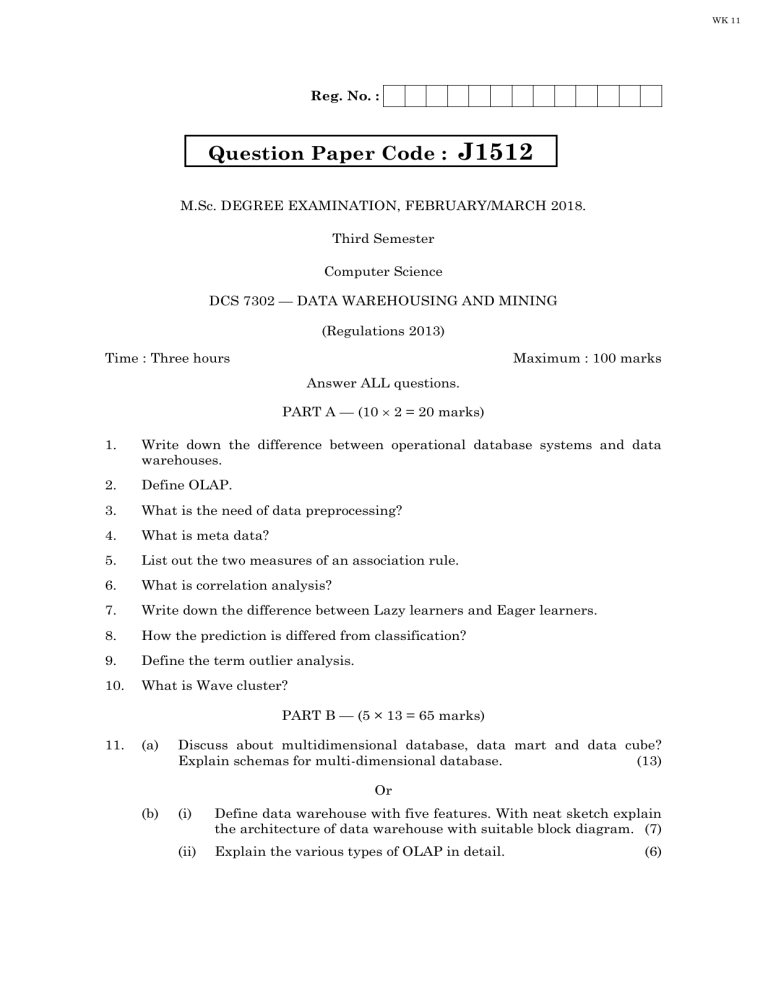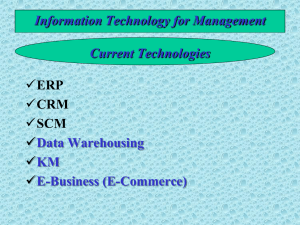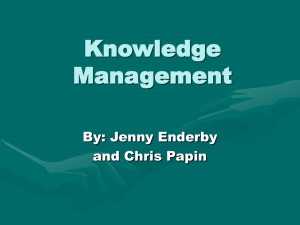Data Warehousing & Mining Exam Paper, M.Sc. Computer Science
advertisement

WK 11
Reg. No. :
Question Paper Code :
J1512
M.Sc. DEGREE EXAMINATION, FEBRUARY/MARCH 2018.
Third Semester
Computer Science
DCS 7302 — DATA WAREHOUSING AND MINING
(Regulations 2013)
Time : Three hours
Maximum : 100 marks
Answer ALL questions.
PART A — (10 2 = 20 marks)
1.
Write down the difference between operational database systems and data
warehouses.
2.
Define OLAP.
3.
What is the need of data preprocessing?
4.
What is meta data?
5.
List out the two measures of an association rule.
6.
What is correlation analysis?
7.
Write down the difference between Lazy learners and Eager learners.
8.
How the prediction is differed from classification?
9.
Define the term outlier analysis.
10.
What is Wave cluster?
PART B — (5 × 13 = 65 marks)
11.
(a)
Discuss about multidimensional database, data mart and data cube?
Explain schemas for multi-dimensional database.
(13)
Or
(b)
(i)
Define data warehouse with five features. With neat sketch explain
the architecture of data warehouse with suitable block diagram. (7)
(ii)
Explain the various types of OLAP in detail.
(6)
WK 11
12.
(a)
Explain with diagrammatic illustration about data mining as a step in
the process of knowledge discovery.
(13)
Or
13.
(b)
List and discuss the steps for integrating a data mining system with a
data.
(13)
(a)
What is called constrain-based mining? Discuss the types of constraints.
Explain Meta rule-Guided Mining of Association Rules and ConstraintBased Pattern Generation: Pruning Pattern Space and Pruning Data
Space.
(13)
Or
(b)
14.
(a)
Write and explain the algorithm for mining frequent item sets without
candidate generation. Consider given database with nine transactions let
min_sup = 30%. Find all frequent item sets.
(13)
TID
List of items_IDS
1
a,b,e
2
b,d
3
b,c
4
a,b,d
5
a,c
6
b,c
7
a,c
8
a,b,c,e
9
a,b,c
Describe various attribution selection measures in classification with
examples.
(13)
Or
(b)
The following table consists of training data from an employee database.
The data have been generalized. For example, “31 .... 35” for age
represents the age range of 31 to 35. For a given row entry, count
represents the number of data tuples having the values for department,
status, age, and salary given in that row.
(13)
Department
Status
Age
Salary
Count
Sales
Senior
31......35
46K......50K
30
Sales
Junior
62......30
26K......30K
40
Sales
Junior
31......35
31K......35K
40
Systems
Junior
21......25
46K......50K
20
2
J1512
WK 11
Systems
Senior
31......35
66K......70K
5
Systems
Junior
26......30
46K......50K
3
Systems
Senior
41......45
66K......70K
3
Marketing
Senior
36......40
46K......50K
10
Marketing
Junior
31......35
41K......45K
4
Secretary
Senior
46......50
36K......40K
4
Secretary
Junior
26......30
26K......30K
6
Let status be the class label attribute.
(i)
How would you modify the basic decision tree algorithm to take into
consideration the count of each generalized data tuple (i.e., of each
row entry)?
(ii)
Use your algorithm to construct a decision tree from the given data.
(iii) Given a data tuple having the values ‘‘systems”, “26...30” and
“46–50K” for the attributes department, age, and salary,
respectively, what would a naive Bayesian classification of the
status for the tuple be?
(13)
15.
(a)
Consider five points {X_1, X_2, X_3, X_4, X_5} with the following
coordinates as a two dimensional sample for clustering. X_1 = (0.5, 2.5);
X_2 = (0, 0); X_3 = (1.5, 1); X_4 = (5, 1); X_5 = (6, 2). Illustrate the
K-means partitioning algorithms using the above data set.
(13)
Or
(b)
(i)
Write the difference between CLARA and CLARANS.
(7)
(ii)
Explain the different types of data used in cluster analysis.
(6)
PART C — (1 × 15 = 15 marks)
16.
(a)
Explain K-means algorithm with an example.
Or
(b)
How you evaluate the accuracy of a classifier (or) predictor?
–––––––––––––
3
J1512
Reg. No. :
Question Paper Code : BS2512
M.Sc. DEGREE EXAMINATION, AUGUST/SEPTEMBER 2017.
Third Semester
Computer Science
DCS 7302 — DATA WAREHOUSING AND MINING
(Regulations 2013)
Time : Three hours
Maximum : 100 marks
Answer ALL questions.
PART A — (10 2 = 20 marks)
1.
What is data mining?
2.
List two applications of data mining.
3.
Differentiate database from a data warehouse.
4.
Give an example of where OLTP is suitable and OLAP is not.
5.
Explain the purpose of data cleaning.
6.
What is Concept Hierarchy?
7.
List two advantages of classification using a decision tree.
8.
What is Support Vector Machine (SVM)?
9.
What is clustering?
10.
How does identification of outliers aid in mining?
PART B — (5 13 = 65 marks)
11.
(a)
Suppose a data warehouse consists of three dimensions time, doctor and
patient and two measures count and charge, where charge is the fee that
a doctor charges a patient for a visit.
(i)
Enumerate three classes of schemas that are popularly used for
modelling data warehouses.
(ii) Draw a schema diagram for above data warehouse using schema
classes listed in (i).
(13)
Or
(b)
12.
(a)
(i)
Explain the architecture of data warehouse.
(6)
(ii)
List differences between OLAP and OLTP.
(3)
(iii) Explain any two OLAP operations with examples.
(4)
(i)
List three major issues in mining data. Explain.
(6)
(ii)
Explain the method used to find proximity measures for attributes
with binary values.
(7)
Or
(b)
(i)
The minimum and maximum values for the attribute ‘income’ are
12,000 and 98,000. With min-max normalization, map a value of
73,600 for ‘income’ to the range [0.0, 1.0].
(4)
(ii)
The mean and standard deviation of the values for the attribute
‘income’ are 54,000 and 16,000. With z-score normalization,
transform a value of 73,600 for income.
(3)
(iii) The attribute age has the values :
33, 40, 21, 25, 13, 22, 15, 30, 19, 35, 16, 20, 16, 22, 25, 25, 33, 36.
Use smoothing by bin means to smooth these data, using a bin
depth of 3.
(4)
13.
(a)
(iv)
What is the need for data reduction?
(2)
(i)
What is Apriori method?
(2)
(ii)
Using the following table, generate Association rules using Apriori
method. Minimum Support = 33%, Minimum confidence = 68%. (11)
TID
List of Items
T001
{Calendar, Stickers, CDs}
T002
(Stickers, Books, Magazines}
T003
{Calendar, Books, Magazines)
T004
{Stickers, Books, Magazines, CDs}
T005
{Magazines, CDs}
T006
{Calendar, CDs}
T007
(Stickers, Books}
T008
{Calendar, Books, CDs)
T009
{Calendar, Stickers, Books, CDs}
T0010
{Books, CDs}
Or
(b)
(i)
What is constraint based association mining? Explain its working
for mining frequent item sets from Transactional databases.
(6)
(ii)
List advantages and disadvantages of the candidate generation. (4)
(iii) How can the efficiency of the association rule mining be enhanced? (3)
2
BS2512
14.
(a)
(i)
Differentiate classification and prediction methods.
(4)
(ii)
What is meant by ‘False Positives’ and ‘True Negatives’ in accuracy
calculation?
(4)
(iii) List the different types of outcome based on splitting criterion. Give
examples for each.
(5)
Or
(b)
Given the following table of students’ grade :
Midterm :
72 50 81 74 94 86 59 83 65 33 88
Final :
84 63 77 78 90 75 49 79 77 52 74
(13)
81
90
Use the method of least squares to find an equation for the prediction of a
student’s final exam grade based on the student’s midterm grade in the
course. Also predict the final exam grade of a student who received an 86
in the midsem exam.
15.
(a)
(i)
Differentiate Agglomerative and Divisive clustering.
(2)
(ii)
How is the k-Medoids clustering method different from
Agglomerative and Divisive clustering. Explain the method and
develop an algorithm.
(11)
Or
(b)
(i)
(ii)
Develop an algorithm for k-means method. Group the following
data set into two groups using k-means algorithm.
(9)
Medicine
Attribute 1(X) : Attribute 2(Y) : pH
weight
index
Medicine A
1
1
Medicine B
2
1
Medicine C
4
3
Medicine D
5
4
Compare the grid-based and density-based methods of clustering.
(4)
PART C — (1 × 15 = 15 marks)
16.
(a)
Consider the following training set for a binary classification problem.
Person-ID Qualification Player Community Class
1
PG
Yes
BC
E1
2
UG
Yes
OC
E1
3
PG
No
MBC
E1
4
UG
Yes
BC
E2
5
UG
No
BC
E2
3
(15)
BS2512
Person-ID Qualification Player Community Class
6
UG
No
MBC
E2
7
PG
Yes
OC
E1
8
PG
No
BC
E1
9
UG
No
MBC
E1
10
UG
Yes
MBC
E2
11
PG
No
BC
E2
12
UG
No
BC
E2
13
PG
Yes
OC
E2
14
PG
Yes
MBC
E1
15
UG
No
BC
E1
Using the table,
(i)
Order the attributes using Information Gain method.
(ii)
Order the attributes using Gain Ratio method.
Or
(b)
What are “Lazy learners”? How are they used for data mining? Give
example.
––––––––––––––––
4
BS2512


